�
Preface
Copyright
This publication, including all photographs, illustrations and software, is protected under
international copyright laws, with all rights reserved. Neither this manual, nor any of the
material contained herein, may be reproduced without written consent of the author.
Version 1.0
Disclaimer
The information in this document is subject to change without notice. The manufacturer
makes no representations or warranties with respect to the contents hereof and specifically
disclaims any implied warranties of merchantability or fitness for any particular purpose.
The manufacturer reserves the right to revise this publication and to make changes from
time to time in the content hereof without obligation of the manufacturer to notify any
person of such revision or changes.
Trademark Recognition
Microsoft, MS-DOS and Windows are registered trademarks of Microsoft Corp.
MMX, Pentium, Pentium-II, Pentium-III, Celeron are registered trademarks of Intel Cor-
poration.
Other product names used in this manual are the properties of their respective owners and
are acknowledged.
Federal Communications Commission (FCC)
This equipment has been tested and found to comply with the limits for a Class B digital
device, pursuant to Part 15 of the FCC Rules. These limits are designed to provide reason-
able protection against harmful interference in a residential installation. This equipment
generates, uses, and can radiate radio frequency energy and, if not installed and used in
accordance with the instructions, may cause harmful interference to radio communications.
However, there is no guarantee that interference will not occur in a particular installation.
If this equipment does cause harmful interference to radio or television reception, which
can be determined by turning the equipment off and on, the user is encouraged to try to
correct the interference by one or more of the following measures:
•
•
•
•
Reorient or relocate the receiving antenna
Increase the separation between the equipment and the receiver
Connect the equipment onto an outlet on a circuit different from that to which
the receiver is connected
Consult the dealer or an experienced radio/TV technician for help
Shielded interconnect cables and a shielded AC power cable must be employed with this
equipment to ensure compliance with the pertinent RF emission limits governing this
device. Changes or modifications not expressly approved by the system’s manufacturer
could void the user’s authority to operate the equipment.
Preface
�
ii
Declaration of Conformity
This device complies with part 15 of the FCC rules. Operation is subject to the following
conditions:
•
•
This device may not cause harmful interference, and
This device must accept any interference received, including interference
that may cause undesired operation
Canadian Department of Communications
This class B digital apparatus meets all requirements of the Canadian Interference-causing
Equipment Regulations.
Cet appareil numérique de la classe B respecte toutes les exigences du Réglement sur le
matériel brouilieur du Canada.
About the Manual
The manual consists of the following:
Chapter 1
Introducing the Motherboard
Chapter 2
Installing the Motherboard
Chapter 3
Using BIOS
Describes features of the motherboard.
Go to page 1
Describes installation of motherboard
components.
Go to page 7
Provides information on using the BIOS
Setup Utility.
Go to page 27
Chapter 4
Using the Motherboard Software
Describes the motherboard software
Go to page 49
Preface
�
iii
TTTTTABLE OF CONTENTS
ABLE OF CONTENTS
ABLE OF CONTENTS
ABLE OF CONTENTS
ABLE OF CONTENTS
Preface
i
Chapter 1
Introducing the Motherboard
1
1
Introduction.................................................................................................1
Feature..........................................................................................................2
Motherboard Components........................................................................4
7 7 7 7 7
Chapter 2
Installing the Motherboard 7
Safety Precautions......................................................................................7
Choosing a Computer Case.......................................................................7
Installing the Motherboard in a Case......................................................7
Checking Jumper Settings.........................................................................8
Setting Jumpers..............................................................................8
Checking Jumper Settings..............................................................9
Jumper Settings..............................................................................9
Connecting Case Components...............................................................10
Front Panel Header.....................................................................12
Installing Hardware...................................................................................13
Installing the Processor...............................................................13
Installing Memory Modules.........................................................15
Installing a Hard Disk Drive/CD-ROM/SATA Hard Drive........17
Installing a Floppy Diskette Drive...............................................19
Installing Add-on Cards..............................................................20
Connecting Optional Devices......................................................22
Connecting I/O Devices..........................................................................26
Chapter 3
Using BIOS
27 27 27 27 27
27
About the Setup Utility............................................................................27
The Standard Configuration........................................................27
Entering the Setup Utility..............................................................27
Updating the BIOS.......................................................................29
Using BIOS................................................................................................29
Standard CMOS Features...........................................................30
Advanced BIOS Features.............................................................32
�
iv
Advanced Chipset Features.........................................................35
Integrated Peripherals.................................................................37
Power Management Setup...........................................................41
PNP/PCI Configurations............................................................43
PC Health Status..........................................................................44
Frequency Control.......................................................................45
Load Fail-Safe Defaults...............................................................46
Load Optimal Defaults................................................................46
Set Supervisor/User Password...................................................46
Save Changes and Exit................................................................47
Exit Without Saving......................................................................47
Chapter 4
Using the Motherboard Software
49 49 49 49 49
49
About the Software CD-ROM................................................................49
Auto-installing under Windows 98/ME/2000/XP................................49
Running Setup..............................................................................50
Manual Installation..................................................................................52
Utility Software Reference.......................................................................52
Multi-Language Translation
�
1
Chapter 1
Introducing the Motherboard
Introduction
Thank you for choosing the 915G-M5 motherboard. This motherboard is a high perfor-
mance, enhanced function motherboard that supports LGA775 Socket for latest Intel
Pentium 4/Celeron processors for high-end business or personal desktop markets.
The motherboard may support 915G Northbridge (NB) and ICH6 Southbridge (SB) chipsets.
The 915G Northbridge on this motherboard supports a Front Side Bus (FSB) frequency of
800/533 MHz using a scalable FSB Vcc_CPU. The memory controller supports DDR
memory DIMM frequencies of 333MHz and 400 MHz. It supports four DDR Sockets with
up to maximum memory of 4 GB. DDR Maximum memory bandwidth of 3.2 GB/s in single-
channel mode and 6.4 GB/s in dual-channel mode is supported. One 16-lane PCI Express
port, intended for Graphics Interface, is fully compliant to the PCI Express Base Specifica-
tion revision 1.0a.
The ICH6 Southbridge on this motherboard supports three PCI slots which are PCI 2.3
compliant. It implements an EHCI compliant interface that provides 480Mb/s bandwidth
for eight USB 2.0 ports, AC’97 CODEC that features a 6-channel audio speaker out, One
onboard IDE connector supports 2 IDE devices in ATA-100/66 mode. The Southbridge
integrates a Serial ATA host controller that is SATA v1.0 compliant, supporting four SATA
ports with maximum transfer rate up to 150 MB/s each.
The 915G-M5 motherboard is equipped with advanced full set of I/O ports in the rear panel,
including PS/2 mouse and keyboard connectors, COM1, LPT, four USB ports, one VGA
port, one optional LAN port, and audio jacks for microphone, line-in, and 8-channel line-
out.
Introducing the Motherboard
�
2
Feature
Accommodates Intel P4/Celeron processors
Supports a system bus (FSB) of 800/533MHz
Supports “Hyper-Threading” technology CPU
Processor
The 915G-M5 uses a LGA775 type of Pentium 4 that carries the following features:
•
•
•
“Hyper-Threading” technology enables the operating system into thinking it’s hooked
up to two processors, allowing two threads to be run in parallel, both on separate
“logical” processors within the same physical processor.
Chipset
The 915G Northbridge (NB) and ICH6 Southbridge (SB) chipset are based on an inno-
vative and scalable architecture with proven reliability and performance.
915G (NB)
•
•
•
•
Supports 32-bit host bus addressing, allowing the CPU to
access the entire 4 GB of the memory address space.
Has a 12-deep In-Order Queue to support up to twelve
outstanding piplined address requests on the host bus.
Supports 256-Mb, 512-Mb and 1-Gb DDR/DDR2 technolo-
gies for x8 and x16 devices
Provides an integrated graphics device delivering cost com-
petitive 3D, 2D and video capabilities.
915G chipset can only support 256-Mb, 512-Mb and 1-Gb DDR tech-
nologies for x8 and x16 device, NOT support 128-Mb DDR technology.
That is, 256 MB Double Side Memory Module & 128 MB Single Side
Memory Module are NOT support.
ICH6 (SB)
•
•
•
•
Enhanced DMA Controller, interrupt controller, and timer func-
tions
Compliant with PCI 2.3 specificaiton
Compliant with Serial ATA 1.0a specification
Integrated USB 2.0 Host Controller supporting up to eight
USB 2.0 ports
Integrated LAN controller
Integrated IDE controller supports Ultra ATA100/66/33
•
•
Accommodates four unbuffered DIMMs
Up to 1 GB per DIMM with maximum memory size up to 4 GB
Memory
•
•
Graphics
•
•
•
•
Onboard LAN (Optional)
Supports core frequency of 333 MHz
Supports 3D Setup, Render Engine, and 3D Graphics Enhancements
Supports High Quality Texture Engine
Video DVD/PC-VCR
This motherboard may support either of the following LAN chipset:
•
•
•
•
•
•
Supports 100/10 Mb/s N-Way Auto negotiation operation
Half/Full duplex capability
Supports Wake-On-LAN(WOL) function and remote wake-up
Integrate 10/100/1000 transceiver
Supports PCI v2.3, 32-bit, 33/66MHz
Supports fully with IEEE802.3, IEEE802.3u and IEEE802.3ab
Introducing the Motherboard
�
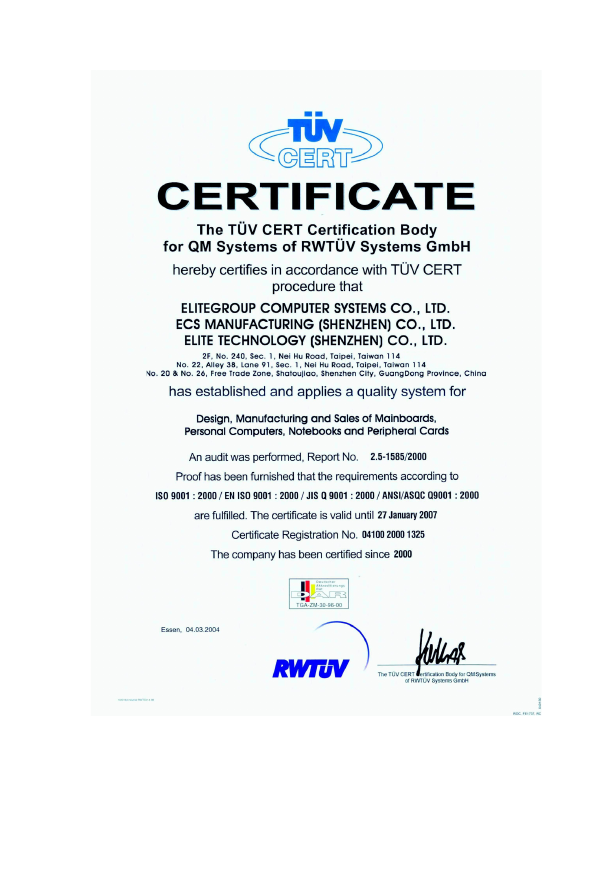
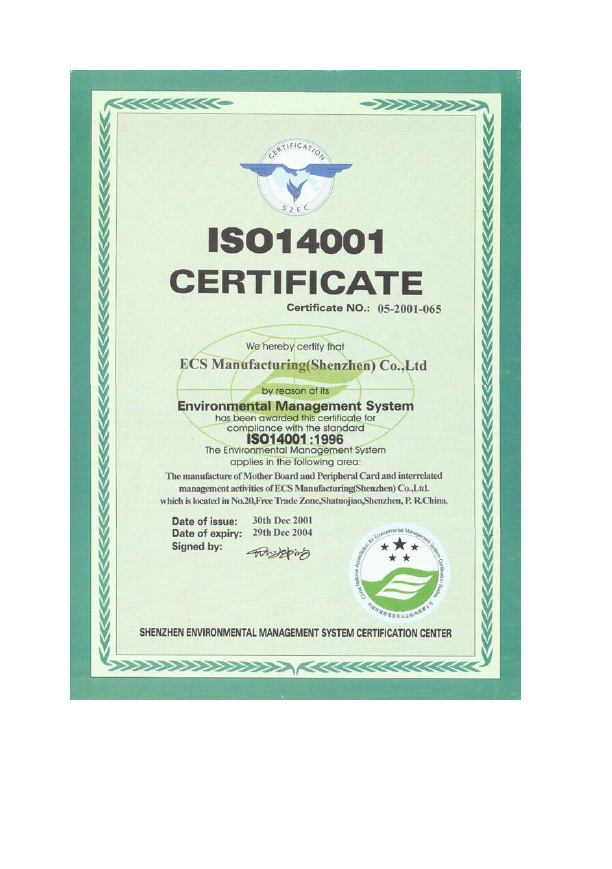

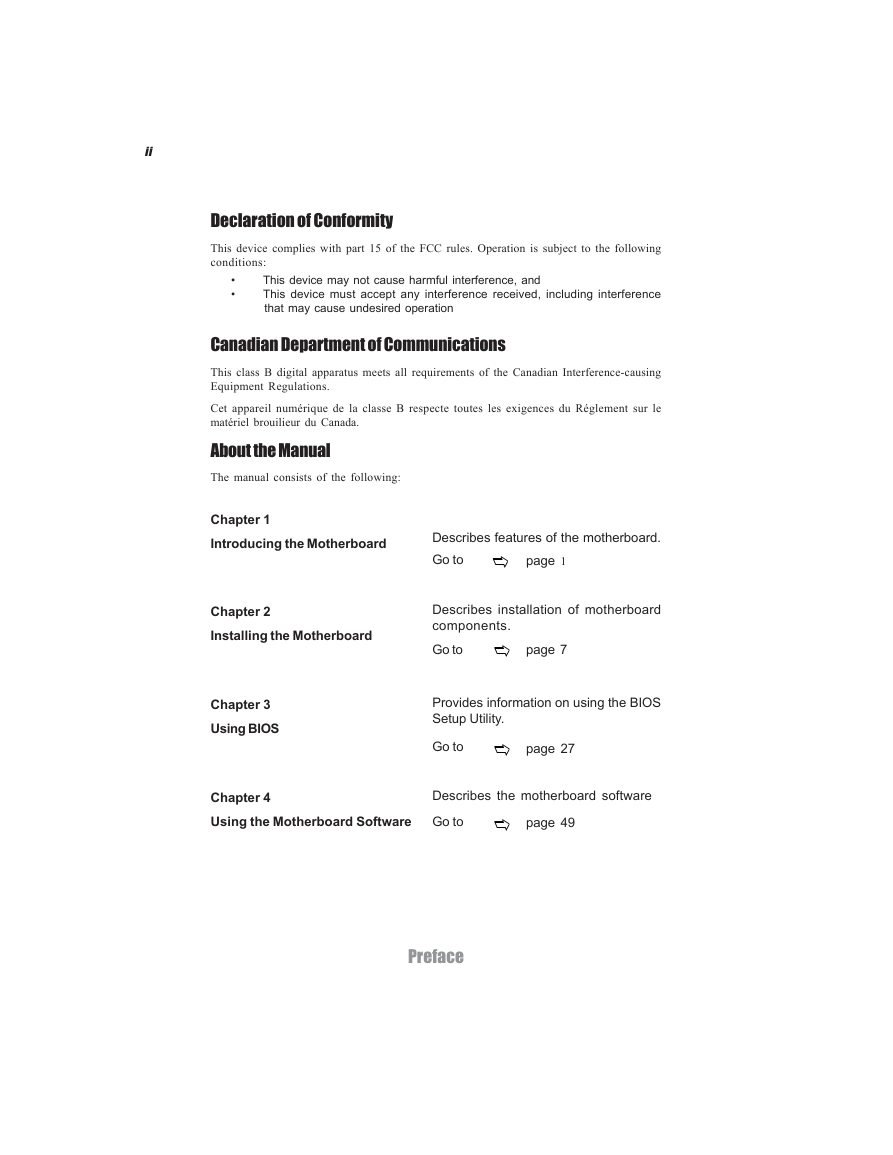
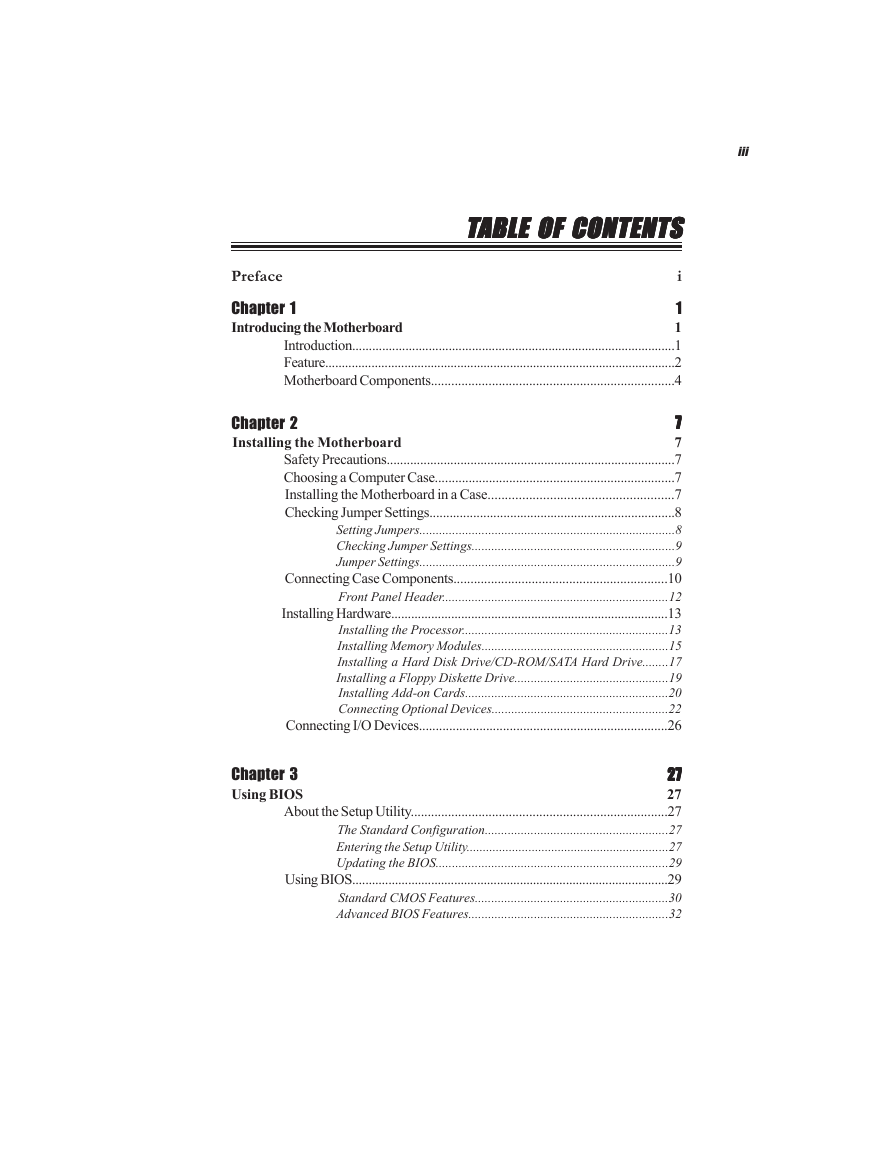
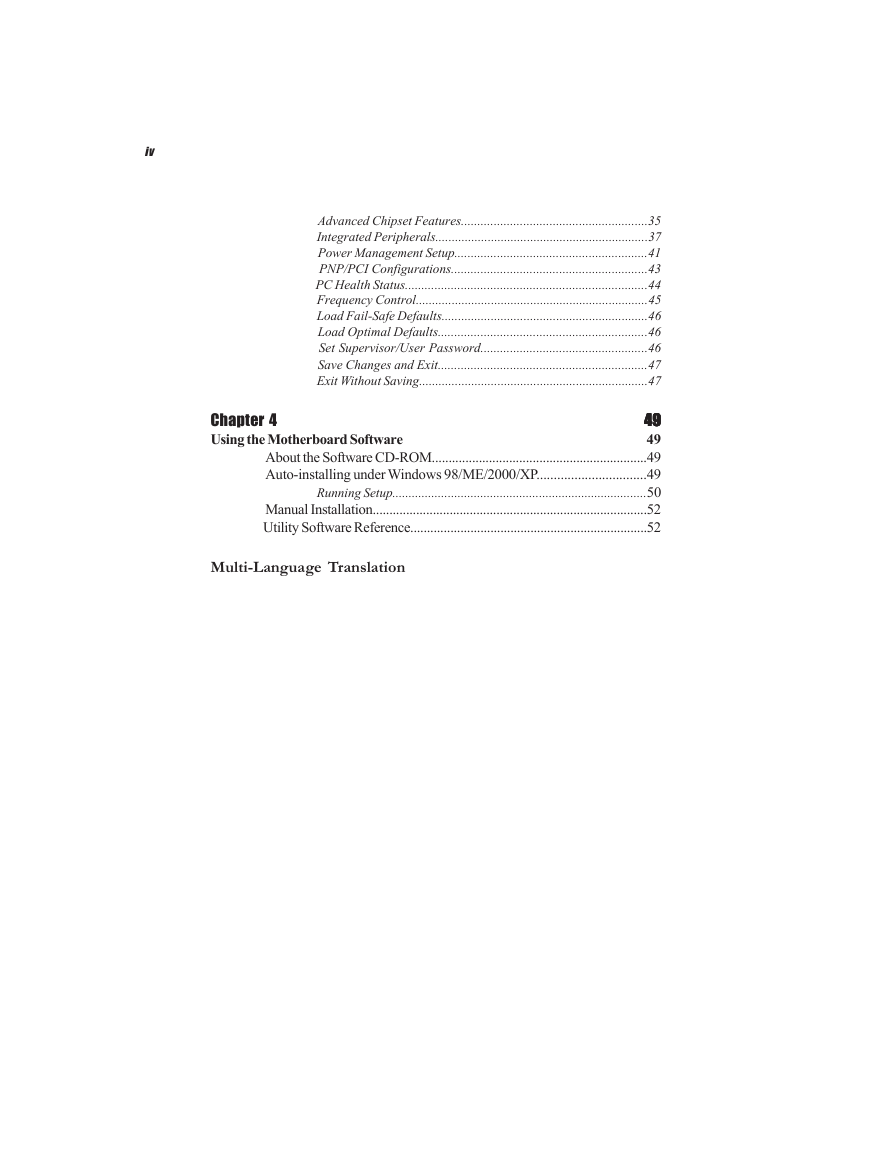
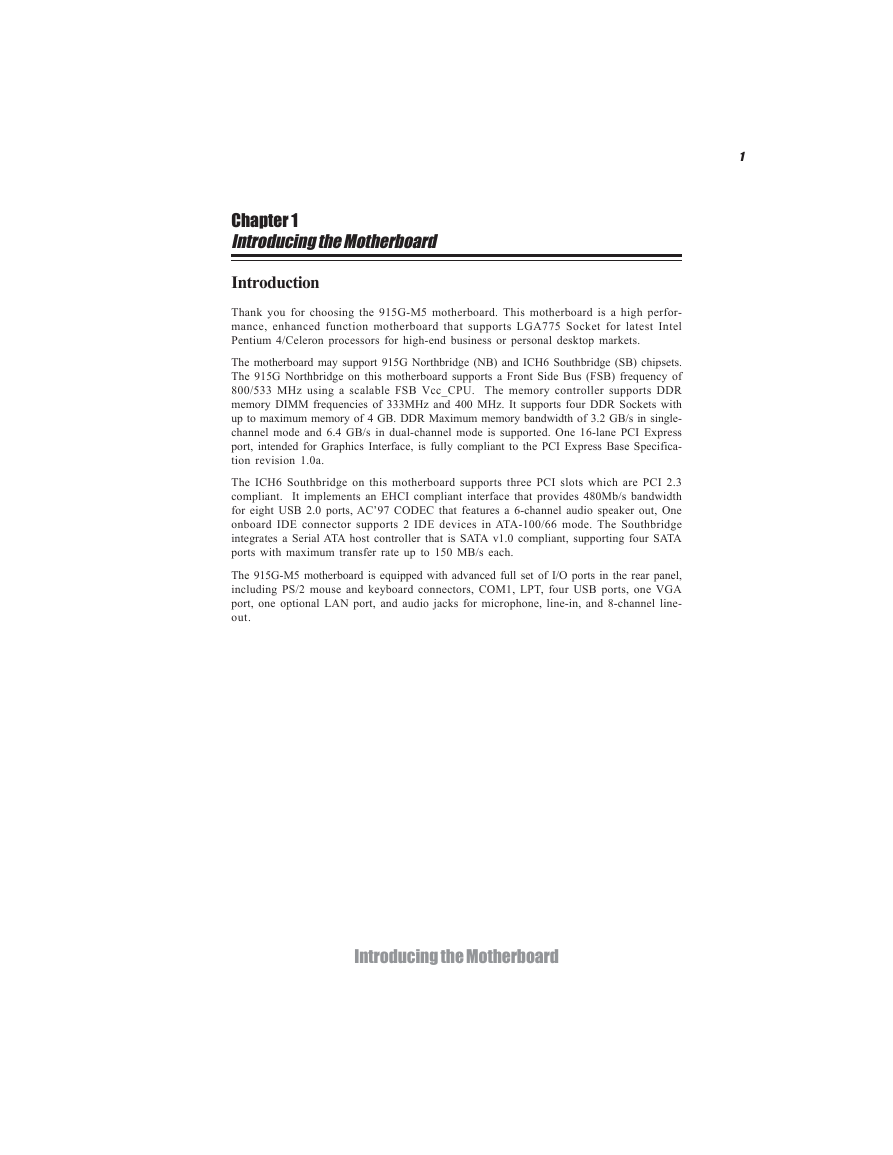
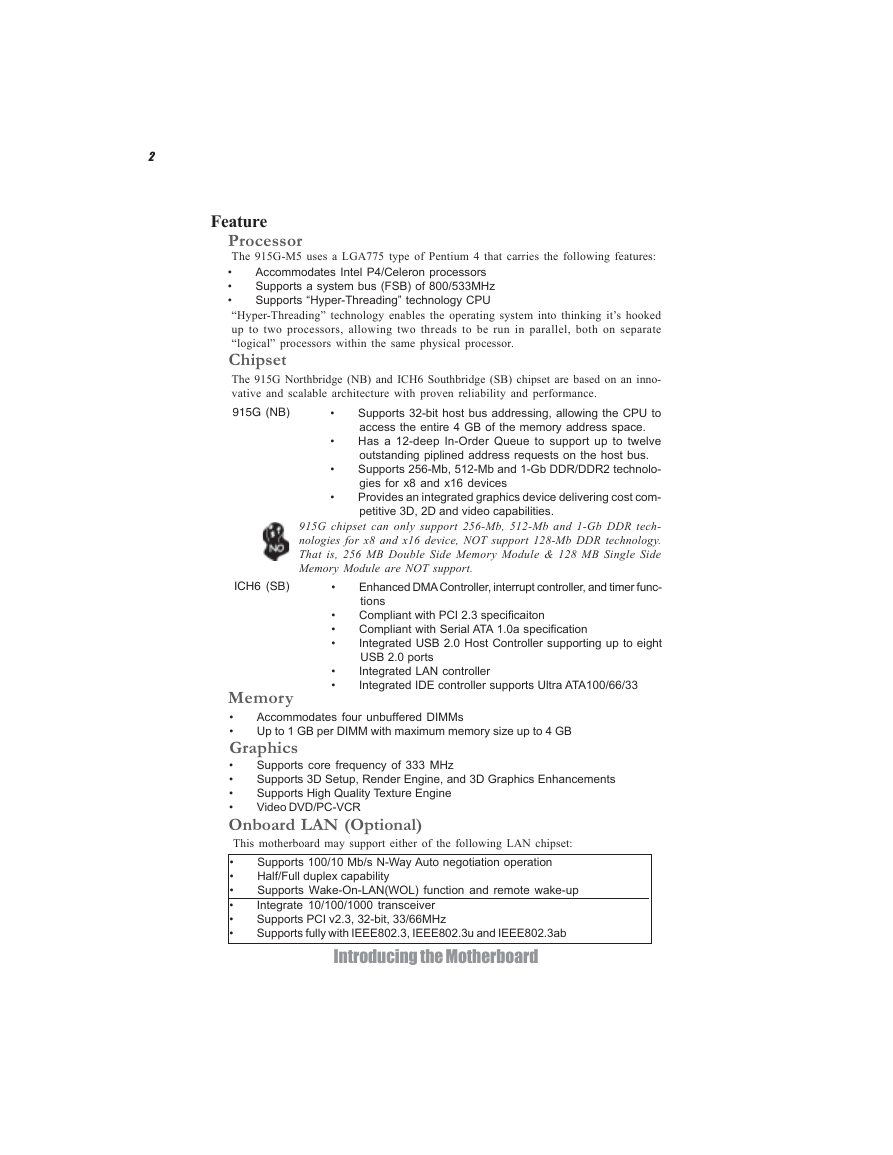








 2023年江西萍乡中考道德与法治真题及答案.doc
2023年江西萍乡中考道德与法治真题及答案.doc 2012年重庆南川中考生物真题及答案.doc
2012年重庆南川中考生物真题及答案.doc 2013年江西师范大学地理学综合及文艺理论基础考研真题.doc
2013年江西师范大学地理学综合及文艺理论基础考研真题.doc 2020年四川甘孜小升初语文真题及答案I卷.doc
2020年四川甘孜小升初语文真题及答案I卷.doc 2020年注册岩土工程师专业基础考试真题及答案.doc
2020年注册岩土工程师专业基础考试真题及答案.doc 2023-2024学年福建省厦门市九年级上学期数学月考试题及答案.doc
2023-2024学年福建省厦门市九年级上学期数学月考试题及答案.doc 2021-2022学年辽宁省沈阳市大东区九年级上学期语文期末试题及答案.doc
2021-2022学年辽宁省沈阳市大东区九年级上学期语文期末试题及答案.doc 2022-2023学年北京东城区初三第一学期物理期末试卷及答案.doc
2022-2023学年北京东城区初三第一学期物理期末试卷及答案.doc 2018上半年江西教师资格初中地理学科知识与教学能力真题及答案.doc
2018上半年江西教师资格初中地理学科知识与教学能力真题及答案.doc 2012年河北国家公务员申论考试真题及答案-省级.doc
2012年河北国家公务员申论考试真题及答案-省级.doc 2020-2021学年江苏省扬州市江都区邵樊片九年级上学期数学第一次质量检测试题及答案.doc
2020-2021学年江苏省扬州市江都区邵樊片九年级上学期数学第一次质量检测试题及答案.doc 2022下半年黑龙江教师资格证中学综合素质真题及答案.doc
2022下半年黑龙江教师资格证中学综合素质真题及答案.doc